Family name: Cannaceae A.L. Jussieu
Synonym(s): [none]
Common name(s): canna family
*Number of genera/species: 1/10
List of genera records in GRIN-Global
seed
Fruit a loculicidalloculicidal:
type of capsular dehiscence, opening longitudinally through the locules (compare septicidal)
 capsulecapsule:
capsulecapsule:
a dry, dehiscent fruit derived from a compound ovary , 15–100 mm long, globoseglobose:
, 15–100 mm long, globoseglobose:
3D shape—more or less spherical to ellipsoidellipsoid:
to ellipsoidellipsoid:
3D shape—elliptic
, angledangular:
2D shape—having sides that meet at acute or obtuse angles
in transection, crowned by persistent tepalstepal:
a member of the perianth, when it cannot be differentiated into a calyx and corolla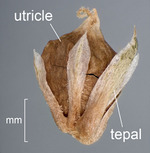 , with few to many seeds. Pericarppericarp:
, with few to many seeds. Pericarppericarp:
fruit wall or fruit coat
brown, green, brown, or white, firm, glabrousglabrous:
without hairs
, with large, soft, conicalconical:
3D shape—cone-shaped, with the point of attachment at the broad end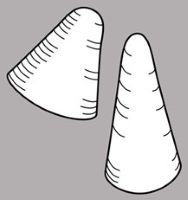 warts.
warts.
Seeds globoseglobose:
3D shape—more or less spherical , ovoidovoid:
, ovoidovoid:
3D shape—ovate , or ellipsoidellipsoid:
, or ellipsoidellipsoid:
3D shape—elliptic
, tereteterete:
approximately circular in cross section; width and thickness approximately equal
 in transection, 3.5–10 mm long. Seeds with a distinct lid for germination on the conspicuous rapheraphe:
in transection, 3.5–10 mm long. Seeds with a distinct lid for germination on the conspicuous rapheraphe:
a ridge or seam on the seed coat, formed by the portion of the funiculus united to the ovule wall in longitudinally curved ovules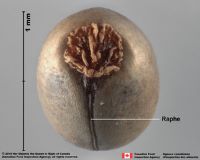 , like an operculumoperculum:
, like an operculumoperculum:
a dehiscent cap (or lid) of a seed or fruit that opens during germination or dehiscence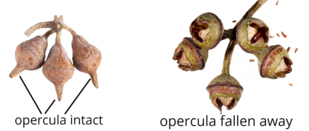 but unique to the family. Seeds with micropylar collarmicropylar collar:
but unique to the family. Seeds with micropylar collarmicropylar collar:
collar shaped tissue at micropyle
. Seed coat black or brown, shinyshiny:
uniformly reflecting a high proportion of incident light at all angles , coriaceouscoriaceous:
, coriaceouscoriaceous:
texture—leathery
or hard, punctatepunctate:
surface relief—dotted with pits or with translucent, sunken glands or with colored dots, similar to pitted . Seeds are embedded in hairs derived from funiculifuniculus:
. Seeds are embedded in hairs derived from funiculifuniculus:
(alt. funicle) stalk connecting the ovule (later seed) to the ovary (later fruit) placenta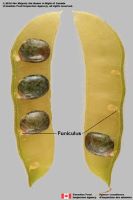 , sometimes interpreted as arils; hairs remain on the capsulecapsule:
, sometimes interpreted as arils; hairs remain on the capsulecapsule:
a dry, dehiscent fruit derived from a compound ovary wall after seeds are shed.
wall after seeds are shed.
Embryo well developed, linearlinear:
(shape) long, narrow, and uniform in width; (of embryo) embryo is straight and much longer than wide , extends into depression or cup at one of the seed and surrounded by a thin layer of endosperm and copious, very hard, perispermperisperm:
, extends into depression or cup at one of the seed and surrounded by a thin layer of endosperm and copious, very hard, perispermperisperm:
seed nutritive tissue comparable to the endosperm, but derived from the nucellus (maternal tissue)
.
Nutritive tissue both scanty endosperm and copious, very hard, perispermperisperm:
seed nutritive tissue comparable to the endosperm, but derived from the nucellus (maternal tissue)
.
| Fruit | |
| Type | loculicidalloculicidal: type of capsular dehiscence, opening longitudinally through the locules (compare septicidal)  capsulecapsule: capsulecapsule:a dry, dehiscent fruit derived from a compound ovary  |
| Size range | 15–100 mm long |
| Shape(s) | globoseglobose: 3D shape—more or less spherical  , ellipsoidellipsoid: , ellipsoidellipsoid:3D shape—elliptic , ovoidovoid: 3D shape—ovate  |
| Texture | firm |
| Surface relief | wartywarty: surface relief—distinct, rounded projections that are large relative to the fruit size; tuberculate, verrucose  |
| Color(s) | brown, green, brown, white |
| Unique features | CapsulesCapsule: a dry, dehiscent fruit derived from a compound ovary  with soft, conicalconical: with soft, conicalconical:3D shape—cone-shaped, with the point of attachment at the broad end  warts 1–2 mm long, opening by three loculicidalloculicidal: warts 1–2 mm long, opening by three loculicidalloculicidal:type of capsular dehiscence, opening longitudinally through the locules (compare septicidal)  slits, starting apically, and often only partially opening. Pericarppericarp: slits, starting apically, and often only partially opening. Pericarppericarp:fruit wall or fruit coat sheds warts as it matures often only a reticulatereticulate: surface relief—netted, raised walls or concave grooves forming a net-like surface pattern with flat, concave, or convex interspaces  and scariousscarious: and scariousscarious:texture—dry, thin, membranous, non-green, more or less translucent surface remaining. Seeds are embedded in simple, curly, hairs up to 3 mm long that emerge from the funiculifuniculus: (alt. funicle) stalk connecting the ovule (later seed) to the ovary (later fruit) placenta  . Seeds fully released as pericarppericarp: . Seeds fully released as pericarppericarp:fruit wall or fruit coat decays. |
| Seed | |
| Size range | 3.5–10 mm long |
| Shape(s) | globoseglobose: 3D shape—more or less spherical  , ellipsoidellipsoid: , ellipsoidellipsoid:3D shape—elliptic , ovoidovoid: 3D shape—ovate  |
| Surface relief | punctatepunctate: surface relief—dotted with pits or with translucent, sunken glands or with colored dots, similar to pitted  |
| Color(s) | brown, black |
| Unique features | Seeds with very hard seed coats, distinct lids for germination on the conspicuous raphaeraphe: a ridge or seam on the seed coat, formed by the portion of the funiculus united to the ovule wall in longitudinally curved ovules  and with micropylar collarsmicropylar collar: and with micropylar collarsmicropylar collar:collar shaped tissue at micropyle . |
| Other | |
| Embryo | well developed, linearlinear: (shape) long, narrow, and uniform in width; (of embryo) embryo is straight and much longer than wide  , extends into depression or cup at one of the seed , extends into depression or cup at one of the seed |
| Nutritive tissue | endosperm scanty; perispermperisperm: seed nutritive tissue comparable to the endosperm, but derived from the nucellus (maternal tissue) copious and very hard |
Neotropics, including subtropics.
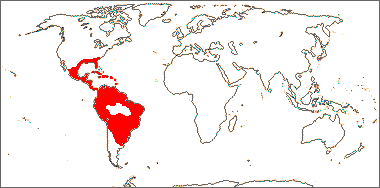
Distribution map courtesy of Angiosperm Phylogeny Website.
Baskin and Baskin 2021Baskin and Baskin 2021:
Baskin C and Baskin J. 2021. Relationship of the lateral embryo (in grasses) to other monocot embryos: A status up-grade. Seed Science Research 31 (3): 199-210. doi:10.1017/S0960258521000209; Dahlgren et al. 1985Dahlgren et al. 1985:
Dahlgren RMT, Clifford HT, and Yeo PF. 1985. The families of the monocotyledons: structure, evolution, and taxonomy. Springer-Verlag, Berlin. 520 pp.; Flora of North America Editorial Committee 1993+Flora of North America Editorial Committee 1993+:
Flora of North America Editorial Committee, eds. 1993+. Flora of North America North of Mexico [Online]. 22+ vols. Flora of North America Association, New York and Oxford. Accessed January-March 2024. URL: http://beta.floranorthamerica.org.; Kirkbride et al. 2006Kirkbride et al. 2006:
Kirkbride JH, Jr, Gunn CR, and Dallwitz MJ. 2006. Family guide for fruits and seeds, vers. 1.0. Accessed September 2020-January 2022. URL: https://nt.ars-grin.gov/seedsfruits/keys/frsdfam/index.cfm .; Kubitzki et al. 1990+Kubitzki et al. 1990+:
Kubitzki K et al., eds. 1990+. The families and genera of vascular plants. 7+ vols. Berlin etc.; Maas-Van de Kamer and Maas 2008Maas-Van de Kamer and Maas 2008:
Maas-Van de Kamer H and Maas PJM. 2008. The Cannaceae of the world. Blumea: Journal of Plant Taxonomy and Plant Geography 53 (2): 247-318. http://dx.doi.org/10.3767/000651908X607945; Stevenson and Loconte 1995Stevenson and Loconte 1995:
Stevenson DW and Loconte H. 1995. A cladistic analysis of monocot families. In: Rudall PJ, Cribb PJ, Cutler DF, and Humphries CJ, eds. Monocotyledons: Systematics and Evolution. Royal Botanic Gardens, Kew.
*The number of genera and species is based on Christenhusz and Byng 2016Christenhusz and Byng 2016:
Christenhusz MJM and Byng JW. 2016. The number of known plant species in the world and its annual increase. Phytotaxa 261 (3): 201-217. https://doi.org/10.11646/phytotaxa.261.3.1, which may differ from the number of genera in GRIN-Global.